Basic knowledge when foreigners go to izakaya No.2
Table of contents
1. Izakaya is Japanese food culture
2. In cases only the Japanese menu
3. “Otoshi (Appetizer)” problem
- (1) Violation of the contract to serve food without order and collect the charge
- (2) It is not delicious to collect the fee
- (3) Served foods cannot eat for allergic or under religious precepts
4. What to do if the price is not written
5. Sake that goes well with seafood
3. “Otoshi (Appetizer)” problem
It became a hot topic in Japan a few years ago. Still, when you go to an izakaya in Japan, the problems are “Otoshi (Appetizer)” and “Tsukidashi (Appetizer).” “Otoshi” is mainly in eastern Japan, and “Tsukidashi” is mostly in western Japan. Both refer to small dishes served regardless of the customer’s order. In particular, foreigners who do not know the system of “Otoshi” and “Tsukidashi” seem very dissatisfied.
Moreover, it is a system that is more difficult to understand because many izakayas do not serve “Otoshi” and “Tsukidashi” to customers who do not order alcohol. In contrast, they serve “Otoshi” and “Tsukidashi” to customers who ordered alcohol.
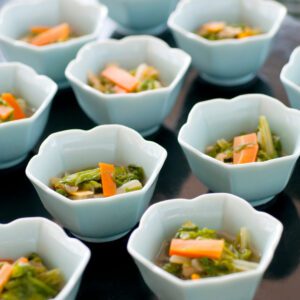
I think the background of the “Otoshi” and “Tsukidashi” problems includes the following three issues. (1) It is a violation of the contract to serve food without order and collect the charge, (2) It is not delicious for collecting the charge, (3) Allergies and religiously inedible foods come out. I think the only way to solve these problems is to abolish “Otoshi” and “Tsukidashi.” However, suppose the izakaya side does not want to cancel it. In that case, it is necessary to devise a way to put out “Otoshi” and “Tsukidashi.” I want to give my opinion on each issue.
(1) Violation of the contract to serve food without order and collect the charge
It is unforgivable for foreigners visiting Japan from a country with a strict contract society to “serve food and collect charges without ordering.” The only way to do this is to force them to follow the Japanese way by saying, “When in Rome, do as the Romans do,” or eliminate the “Otoshi” and “Tsukidashi.” If you want to keep “Otoshi” and “Tsukidashi,” you should not only write the “Otoshi” and “Tsukidashi” charges on the menu but also tell them in advance.
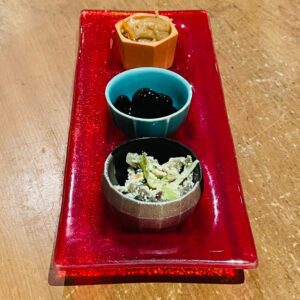
Suppose the izakaya manages its business by collecting “Otoshi” and “Tsukidashi” charges. In that case, the prices of food and beverages should be raised instead of abolishing “Otoshi” and “Tsukidashi.” Japanese izakaya is cheap, so I think most customers won’t complain even if they cancel “Otoshi” and “Tsukidashi” and raise the price of the entire menu little by little. In particular, foreigners who are surprised at the low prices in Japan will not complain at all about the slight price increase.
Even though the customer has not ordered, the izakaya will serve the food and collect the charge, so it complains as a contract violation. I think that the solution to problem (1) is to raise the price of food and beverages instead of abolishing “Otoshi” and “Tsukidashi.”

From the customer’s point of view, it would be very effective for the izakaya to offer “Otoshi” and “Tsukidashi” for free to raise the price of food and beverages. After all, no one gets angry because it is provided free of charge. Also, get free “through” and “protruding” immediately after entering the store. You will have a good impression of the izakaya.
Psychologically, we should focus on the “primacy effect” and the “recency effect.” It is said that the first impression, the “primacy effect,” and the final impression, the “recency effect,” determine the image of things. In other words, the first impression of the “primacy effect” is raised by first serving “Otoshi” and “Tsukidashi” for free. At the final accounting, the “Otoshi” and “Tsukidashi” charges are free and on the receipt. By writing, you can expect the effect of raising the last impression, the “recency effect.”
In French cuisine, “Amuse” may appear as something similar to “Otoshi” and “Tsukidashi.” “Amuse” is often provided free of charge. It is presumed that French restaurants that offer “Amuse” for free, whether intended or not, aimed at the “primacy effect” mentioned above. Of course, even if you provide it for free, “Amuse” should be charged at the price of other dishes and beverages.

In addition, the Japanese cuisine course has “Sakizuke” as something similar to “Otoshi” and “Tsukidashi” in the izakaya. This is included in the course meal so that Japanese cuisine restaurants won’t be charged just for “Sakizuke.” “Amuse” is said to have been born in the 1970s, influenced by the “Sakizuke” of this Japanese cuisine. Since “Sakizuke” is included in the price of course meals, no one in Japan complains about “Sakizuke.” Therefore, if the izakaya emulates the successful examples of “Sakizuke” and “Amuse,” it is crucial in terms of management strategy to provide “Otoshi” and “Tsukidashi” free of charge to raise the price of food and beverages. It can be said that it is effective.
(2) It is not delicious to collect the fee
Customers are also very dissatisfied that it is not delicious the “Otoshi” and “Tsukidashi” charges. There is also excellent izakaya to serve a delightful “Otoshi” and “Tsukidashi.” However, I think some izakaya offers simple “Otoshi” and “Tsukidashi,” mainly chain stores. In particular, dishonest izakaya is problematic because they sometimes charge high fees for simple “Otoshi” and “Tsukidashi.”
When I traveled to a rural area and entered a local izakaya, I was nonplussed
the izakaya’s “Otoshi”. The chef said, “I’m proud of our Otoshi,” and we served “Otoshi,” filled with five types of knobs. Indeed, the content is not harmful, but when asked about the price, it was Yen 800, which significantly exceeds the “Otoshi” fee of about Yen 200 to Yen 500. If we consider it a Yen 800 dish, it doesn’t feel cheap, so the chef doesn’t have to brag about it. Instead, I wanted to order my favorite food myself.

On the other hand, at an izakaya in another region, although the “Otoshi” fee is Yen 500, a large amount of sashimi came out as “Otoshi,” and I was overjoyed. Naturally, this izakaya was very popular, and the customers were full. I estimate that a large amount of sashimi “Otoshi” is making a loss at Yen 500 due to the “primacy effect” mentioned above. Customers are impressed with the izakaya and are ordering other dishes and beverages more and more. Also, it seemed that many customers took pictures of “Otoshi” and posted them on SNS. Izakaya can also aim for this kind of advertising effect. Therefore, depending on the content of “Otoshi,” the negative image of “Otoshi” can be changed to a “positive image.”
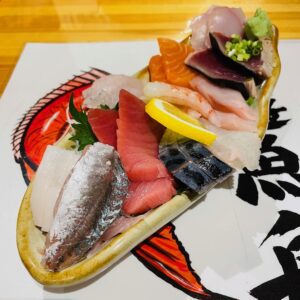
(3) Served foods cannot eat for allergic or under religious precepts
As for point (3), there is no choice but to eliminate “Otoshi” and “Tsukidashi” or to allow the content to be selected. Even high-end izakaya and sushi restaurants ask, “Are there any allergies or dislikes?” However, such izakaya and sushi restaurants may offer the same “Otoshi” and “Tsukidashi” for all customers. This is an example of not worrying about the customer’s “allergies and foods that cannot be eaten due to religious precepts.”

First, I think it is necessary to consider the reason for providing “Otoshi” and “Tsukidashi.” The way the izakaya responds depends on which of the following reasons. (A) Izakaya wants to make a profit by serving “Otoshi” and “Tsukidashi,” (B) simply serving by custom, (C) serving food to please customers. In the case of (A) and (B), it is necessary to eliminate “Otoshi” and “Tsukidashi” and raise the price of other dishes and beverages little by little, and in the case of (C), consider the customer’s “allergies and religiously inedible foods.” Then, it would be best to prepare multiple “through” and “protrusions.”
4. What to do if the price is not written
Occasionally, an izakaya doesn’t have the price on the menu. In particular, there are many cases where the price is not on the menu relatively in the high-class izakaya. This tendency also applies to upscale sushi restaurants.
The main reason why the price is not written on the menu is that it is difficult to change the menu according to the purchase price because the purchase price of fish and shellfish fluctuates daily. In addition, some scam izakaya should refrain from writing the price on the menu and charging an unreasonably high charge at the time of accounting.
In any case, the price is not written on the menu because of the convenience of the izakaya, not the customer. Therefore, I think the price should be written on the menu.
Still, what if we enter an izakaya that doesn’t have a price on the menu?

The best solution is to ask for the price of the meal you want to eat. However, this method is troublesome for both the customer and the restaurant. It is also an impossible solution for foreigners who do not speak Japanese.
Order by “Moriawase”, “Kyo no Osusume”, “Omakase”
The next best option is to order in the form of “Moriawase (platter),” “Kyo no osusume (Today’s Recommendation),” “Omakase (a meal to be selected by the chef),” etc., as suggested in “2. In cases only Japanese menu”. Entering an izakaya that does not have a price written on the menu is almost the same as entering an izakaya with only Japanese for foreigners who cannot read Japanese. Therefore, try ordering “Moriawase,” “Kyo no osusume, “Omakase” instead of ordering a single item.
otukuri--300x300.jpg)
If you order this way and the izakaya offers a lousy meal, they may be a scam izakaya, and you should leave early. On the other hand, if izakaya provides delicious food, it is likely a good restaurant that is particular about fish and shellfish. If the food was delicious and the seats were full, it was likely that it was a conscientious izakaya, even without the price on the menu.
5. Sake that goes well with seafood
If you go to an izakaya, your primary purpose will be to eat good food and drink an excellent alcoholic beverage. Of course, people who cannot drink alcoholic beverages because of their constitution or religion should enjoy meals and non-alcoholic beverages. Still, here we will discuss those who can drink an alcoholic beverage.
For foreigners, sake will be the first alcoholic beverage that Japanese izakaya wants to drink. However, some people order high-priced sake because they think that high-priced sake is delicious and low-priced sake is not.
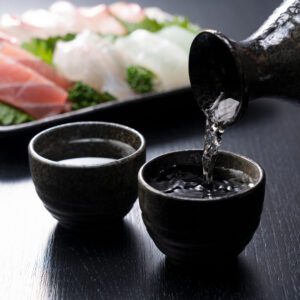
Order Junmai Sake at an izakaya
Here, I would like to give my opinion about ordering sake at an izakaya. In conclusion, the type of sake you order at an izakaya is “Junmai Sake,” which suits almost all dishes, especially for sashimi of fish and shellfish. Many cooks admit that “Junmai Sake” goes well with sashimi and sushi, so there is no doubt. If you order “Junmai Sake,” the izakaya staff will choose the best sake for you. Suppose you don’t have “Junmai Sake” in your izakaya. The price will be a little higher, but “Junmai Ginjo Sake” and “Special Junmai Sake” also go well with many dishes such as seafood sashimi.
So why does “Junmai Sake” go well with izakaya cuisine? This is because it is dry and has a mild aroma among different sakes. “Junmai Sake” is made only from rice, malted rice, and water. Therefore, it goes well with all dishes that go well with rice. Most of the izakaya dishes, such as sashimi, yakitori, and tempura, go well with rice, so it goes well with “Junmai sake.”
“Daiginjo sake” is an apéritif
On the other hand, “Junmai Daiginjo Sake” or “Daiginjo Sake,” which are the leading sakes with high prices, have a strong aroma and are recommended for apéritif. However, it is unsuitable for sake drunk during the meal because it has a strong aroma.
You have the impression that you drank the expensive “Junmai Daiginjo sake.” Still, it didn’t go well with the food at the izakaya or sushi restaurant because you ordered sake that didn’t go well with the food. It’s a pity that I don’t know much about sake, and it’s misunderstood that it doesn’t go well with food. I think izakaya and sushi restaurants should advise foreigners unfamiliar with sake that “Junmai Daiginjo sake ” should be served only as an apéritif.
It has been scientifically analyzed that the sashimi of fish and shellfish, a typical izakaya dish, or the combination of sushi, soy sauce, and sake, is wonderful.

Many fish and shellfish contain a large amount of inosinic acid, one of the “Umami” ingredients. For example, the content of 100g of inosinic acid is 280mg for sardine, 270-330mg for horse mackerel, 250-360mg for tuna, 250-280mg for Spanish mackerel, etc. On the other hand, in meat, pork is 130-230 mg, but chicken is 150-230 mg, and beef is 80 mg.
Synergistic effect of soy sauce
In addition, soy sauce contains a large amount of glutamic acid. The 100g of glutamic acid content is as high as 400-1,700mg. In particular, Tamari soy sauce, a condensed form of umami, and glutamic acid, a sweet soy sauce from the Kyushu region, are around 1,700 mg, the highest class among soy sauces.
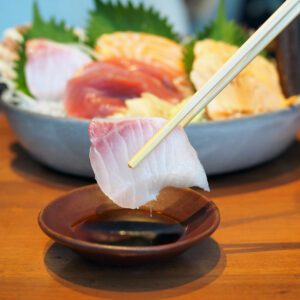
The combination of inosinic acid from fish and shellfish and glutamic acid from soy sauce strengthens the “Umami” (7-8 times). Also, eating sashimi with soy sauce dramatically affects the taste, and the soy sauce eliminates the fishy smell of fish and shellfish.
In addition, sake contains amino acids such as glutamic acid, so if you eat seafood with soy sauce and drink sake, the “umami” will increase, and you will feel delicious. Compared to beer and wine of the same fermented liquor, the amino acid content of sake is 3 for wine and 8 for sake, assuming that beer is 1.
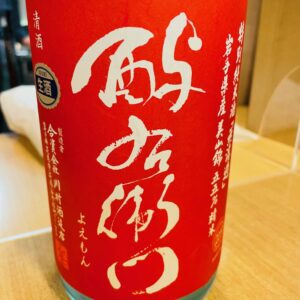
Then, if you scientifically explain whether “Junmai Sake” is suitable for izakaya dishes, the degree of sweetness depends on it. The sweetness and spiciness can be calculated from the sake degree and the total acidity. The higher the sweetness and spiciness value, the sweeter it is; the lower the value, the dryer it is. In addition, dry means not sweet.
The formula the National Tax Agency calculates is sweetness = 193593 / (1443 + sake degree) -1.16 x total acid-13.57. It’s easy to calculate on the Casio website. The average sweetness and spiciness of each sake are -0.52 for “Junmai sake,” -0.27 for “Ginjo sake,” including Daiginjo sake, and -0.3 for “Honjozo sake.” Since the average value of Junmai sake is the dryest (because it is not sweet), it does not interfere with the taste of izakaya dishes. You can feel the synergistic effect of “Umami” more.
Sake is produced based on a very delicate balance. However, it does not mean that sake should be spicy. “Amino acid degree” is not included in the formula for sweetness. Generally, if the “Amino acid degree” is high, it is sweet; if it is low, it is dry. As mentioned above, amino acids produce “umami” and richness. Moreover, if the amino acid content is too high, you will feel a lot of miscellaneous taste.
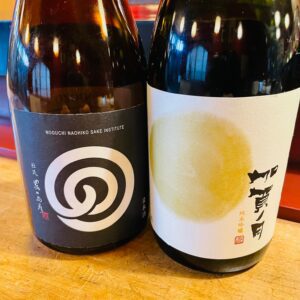
Therefore, you can only order sake during meals, mainly “Junmai Sake,” and remember that sake when you find your favorite sake.
It is best to drink the local “Junmai sake”
As I posted in the Nagasaki / Fukuoka travel edition, sake in Kyushu is very sweet. Still, the food you eat at an izakaya in Kyushu goes well with sweet sake. Since sake made in that region has been made according to the meals served in that region, it is best to drink sake locally for local production for local consumption.

Considering these things comprehensively, it was concluded that drinking the local “Junmai sake.” Please try it at an izakaya.
